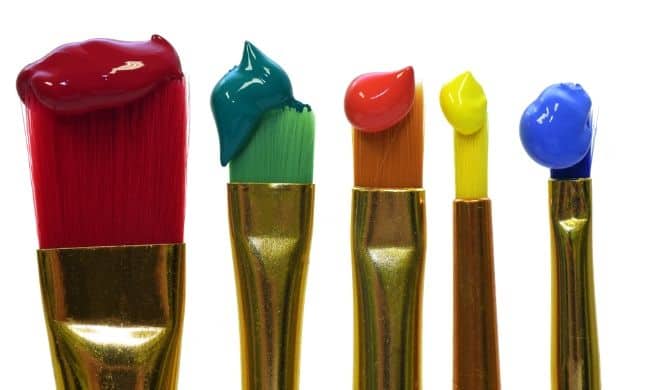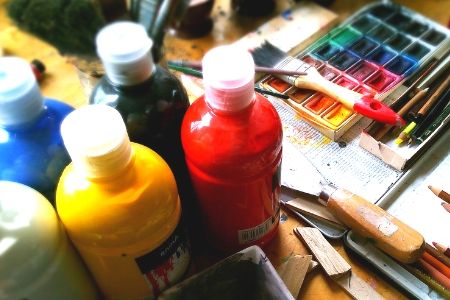When you first decide to paint it can be difficult to decide on what is the best painting medium to use if you are a beginner.
There are several things to think about before deciding which medium to use when you begin painting. Most people consider acrylics to be the easiest to use, to begin with. However, that is not always so. Which paint you choose to learn can depend on other things as well. Below I go over the options for each paint and the other things to think about before choosing your medium.
For many, it will be as simple as choosing the easiest paints to use. However, I feel this more than what is the best paint. Knowing the pros and cons of each type of paint is just the beginning. There is much more to know about choosing the right paint medium for you as a beginner. It’s about you as a person and a painter. What you prefer
I will give examples.
There are lots of reasons to pick a particular medium or type of painting. This goes beyond whether it’s acrylic or watercolor, abstract or controlled. While it is important to like your chosen medium it is only part of the picture.

Your Personality & What Do You Love?
This may not apply to everyone but your personality may play a big part.
For example, I love watercolor. I love the loose-flowing style and the abstract patterns that make a real picture that you recognize. Can I do it, not to save my life can I do it. I have tried many a time for many a year (a bit stubborn lol). Not until I realized this and started to follow the more precise painters.
Why you ask. My personality is about putting the paint where I want it and many of these styles rely on skill combined with “happy” accidents”. I am much better with the styles of the old masters.
It may be that you are the reverse. That you have to have control in your life everywhere else and you just love the wild effects you can get with paint.
Your Location, Space & Circumstances

You may love oil paints more than anything but are you prepared to put up with the constant smell?
Example: When I started oil painting I had a 6’x9’ bedroom, this is where I painted. It didn’t take long to realize that this just wouldn’t work. I soon found somewhere else to paint. Someone kindly let me use the back of a building to paint.
There are many reasons that you might not use oil paints. If you live in a small apartment or cottage with only one room you may find that the smell is overwhelming (or you may like the smell). Not to mention the logistics of having that canvas in your way all day and every day no matter what else you are doing. Oil paints take a long time to dry so you can also damage your work. You would need to find a way to store your art safely while you were not painting.
You may have a family member or pet that is sensitive. I have a cat who is very sensitive to smells. So oil is out unless I either get a separate studio or move.
The oil paints may irritate your skin.
What Medium Is Really The Easiest to Learn?
This in part contradicts the “personality and what you love” section. But for each person, it will be different. One of the most popular questions asked in language learning is “what language is easiest or hardest to learn?” Some will say Esperanto or Spanish is easiest and Chinese more difficult. But the question and answer also apply to art.
“What medium is the easiest and hardest to use?
I don’t care how many people tell you a specific medium is the hardest (usually watercolor) or the easiest (usually acrylic). If you absolutely hate that medium you are going to find it the hardest to use and vice versa. So the medium that you love will be easier. I appreciate you may not know what that is yet.
Try Them Out
If you can try out the different mediums in a relaxed beginners day class. You may be lucky and have access to these. Or there may be an art event near you that allows you to dabble.
Don’t Lock Yourself In
When you start out you may want to experiment and try different mediums. Once you have one you like, keep to that for ages until you are able to use it confidently.
But don’t lock yourself in.
If you then want to try other mediums expand your knowledge and work with others. This really depends on you as a person. Some people will want to use them all while others will find one and be happy with that.
Don’t Get Hung Up on Detail
Take what I have said here as advice or a guide but don’t get hung up on details.
The Fors and Against of Each Paint

The difficulty here is that there are so many variations these days. Oil is not just oil and acrylic is not just one type. I’d like to say they have a specific way of acting. They do but those variables change that.
For this post, I am sticking to the standard versions or it could get really boggy. By standard, I mean the traditional well-known versions.
Acrylic Paint (standard)
Acrylic is fairly new on the block only invented in the 1940s or thereabout. It is a form of plastic acrylic resin.
Acrylic paints overcome many of the disadvantages of oils but they bring with them some of their own difficulties too. Some of these cross over.
The Advantages of Acrylic Paints
- The dry quickly
- They do not smell anywhere near the way oils do
- They are less irritant
- They are easier to use
- Acrylic paints can be used to create watercolor or oil effects.
- They are vibrant (although I know some would disagree)
- They are much easier to clean than oils because they are water-based.
- Much more economical to buy
- They are mostly non-toxic.
The disadvantages of Acrylic Paints
- They dry quickly. No, you are not experiencing deja vu. There are times when they dry too quickly and your work can struggle because of this. You may be working slowly because you are a beginner to a technique or style. Or you may have to leave the painting for a while. They can be difficult to blend due to the fast drying times which can cause issues with things like clouds that look more like cotton balls.
Possible Solutions: There are additives and paint storing methods you can use to help with this to lengthen their paint use.
It also depends on which paint you buy as to their drying times. There are also acrylic paints on the market now where you can re-wet them and continue painting – Yay!
Oil Paint (Standard)
Oil paints have been around forever at least since the 15th century.
Oil paint for
- Beautiful finish
- Rich colors to work with
- Easy to blend colors due to the slower drying times
- Can easily rework and add or remove paint to/from your work.
- Classic
- Longer working time
- More natural
Against
- They are more expensive than acrylic. Paint prices vary depending on the pigment.
- Oil paints smell. This can be overpowering.
- Uses chemicals to clean. Oil has fumes & solvents which are toxic.
- Have to work fat over lean (thick over thin). If you don’t the inside never dries.
- Prone to coloring and yellowing and occasionally cracking with age.
Possible solutions.
It may be possible to get alternatives for cleaning your paints.
There are also variations of paint that have attempted to remove the problems with oil and acrylic. They have succeeded to a degree, but each brings new challenges.
Watercolor (standard)
Although artists mixed their own watercolors before actual watercolors were first available in the 1780s source.
The Advantages of Watercolor.
- Watercolors are much more portable than either oil or acrylic.
- They are great for sketching on the spot.
- Water-Based so no issue with fumes.
- Easy to clean brushes
- Beautiful ethereal feel to the work.
- Beautiful translucent color.
- Low in toxicity
- They are more natural
Disadvantages of Watercolor.
- More expensive.
- Can be difficult to handle.
- People find them hard to learn.
- Paper can ruckle (there are ways around this).
- Difficult to put right errors.
- Easy to muddy.
- Needs to be framed behind glass to be protected
Possible Solutions
You can either stretch your canvas or buy really thick paper to stop or at least reduce ruckling. Some ruckling will disappear when the painting dries.
If you learn good solid watercolor techniques it will reduce errors, and make them easier to handle. Master your wash.
Use pans and not tubes to start with as you are less likely to put too much color on this way.
